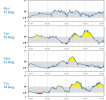This is what I'm currently worried about. Last checkup my HbA1c was 6.8, the nurse saif that was very good. I thought it was supposed to be 6.5(or below). Since I got the Libre, i can see the spikes and the plunges. I know what causes the spikes (anything that tastes nice!), but the plunges. I'd like to get more level, but am finding it difficult. I use Humulin I and Humalog twice a day. When I was diagnosed the advice was 'eat starchy carbs at every meal, and keep the fat low, no snacking on cheese!' I feel great on this, I love carbs, but in the long term it doesn't seem like a good idea. I particularly worry about my eyesight - I have cataracts developing. Still not at the point of needing surgery thank goodness. The plunges are a problem if I'm at work, I'm on my feet and sometimes I feel s if I;m mainlining dextrose, which can't be good.
Can you post a photo of a typical day's Libre graph showing the spikes and plunges?
If you are needing glucose tablets between meals then you are having too much insulin. It can be a real temptation to increase mealtime doses to reduce spikes when what is often needed is to change the timing of the insulin rather than increasing it. The key way to tell is if your levels return to target by the next meal when your Humalog is finished working, then your insulin dose was correct and you reduce any spike by injecting that dose a bit earlier before eating. This is called the prebolus timing and is crucial to reducing spikes. Most nurses advise injecting 10-20 mins before your meal, but to prevent spikes you often need to increase that, especially at breakfast time when the liver is releasing a strong flow of glucose into your blood stream before you even think about eating breakfast. I found that I needed to inject and then wait over an hour before eating breakfast to prevent large spikes from breakfast with Novo(not so)Rapid. I now have one of the fastest insulins Fiasp, but still need to inject and wait 45 mins on a morning before eating breakfast. Less if my BG is in the 4s on waking.
If your levels spike high and then come crashing back down into a hypo later, then you need to increase the prebolus timing but decrease the dose.
If you go high after a meal and stay high until the next meal, then you probably need to adjust the prebolus timing and also need more insulin.
The above all depends on you having your basal insulin dose, Humulin i, optimised to keep your levels steady in the absence of food and Humalog.
If you can post a picture of a typical day on your Libre showing the typical peaks and troughs you see we might be able to advise you better. It really helps to notate on the Libre when you inject and when you eat, so that you can see the current prebolus timings.
When you are adjusting the timing, it is important to start with what you do now, which might be say 10 mins and add 5 mins more every few days until you start to see the spike coming down to a more acceptable level. If you just try 45 mins or whatever when you currently just inject 10 mins before, then you might easily end up hypo. Just because 45 mins works for me with my insulin and my breakfast choice and my digestion/metabolism, absolutely doesn't mean it will work for you, so it is important to increase it gradually until you find the sweet spot timing for your body/insulin/food.
Also important to know that breakfast is usually the meal that needs the longest prebolus time, and lunch and evening meal may need a lot less, so don't assume that once you figure it out for breakfast, it is the same at other times of the day. It can also vary with BG level, so if you BG is low before your meal, you will likely need less prebolus time than if you are above target (over 7) and if I am above 10 I could be waiting hours for my levels to come down before I eat breakfast, but that tends to need a slightly different approach.
Hopefully that all makes sense. It sounds complicated but in practice Libre makes it a lot easier and once you start increasing the prebolus timing you should start to see the height of the peaks reduce, just don't be too heavy handed and try to do it too quickly. Slow steady increases in the timing of a few minutes every few days should start to show results. You don't want to end up having a horrible hypo on the way to work because you prebolused too far ahead.

